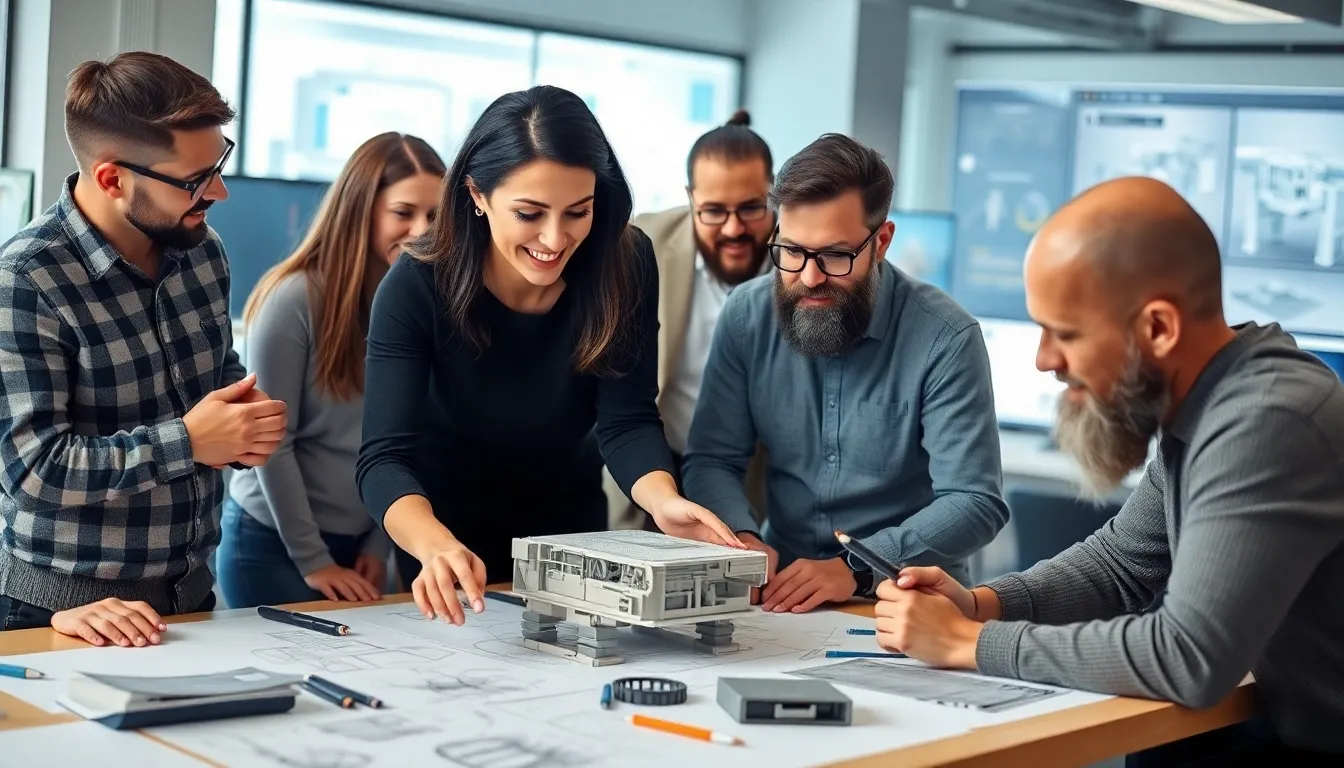Table of Contents
ToggleEngineering design concepts are the secret sauce behind everything from sleek smartphones to towering skyscrapers. They blend creativity with technical know-how, turning wild ideas into tangible solutions. Imagine a world where engineers can conjure up the next big thing with just a sketch and a sprinkle of ingenuity. Sounds magical, right?
Overview of Engineering Design Concepts
Engineering design concepts encompass various methods and principles that engineers utilize to create innovative solutions. These concepts bridge the gap between imagination and functionality. They stress the importance of defining a problem, generating ideas, and evaluating potential solutions to ensure feasibility.
The design process typically involves several stages, such as problem identification, research, concept development, prototyping, and testing. Each stage plays a critical role in refining ideas and determining the best approach. During problem identification, engineers carefully outline the challenges they need to address. Research follows, where engineers gather relevant information, study existing solutions, and analyze user needs.
In concept development, engineers brainstorm various design alternatives. Creativity shines during this stage, as teams collaborate to explore unique approaches. Prototyping allows for the physical manifestation of ideas, enabling testing to confirm functionality. Testing must occur iteratively, ensuring that designs meet performance criteria and user requirements.
Iteration serves as a cornerstone of the design process. Engineers frequently revisit earlier steps based on feedback garnered during testing. This continuous improvement helps identify flaws and enhances design quality. Feedback from users provides invaluable insights, guiding further refinements and adjustments.
Collaboration among multidisciplinary teams often produces the most successful outcomes. Engineers work alongside designers, marketers, and stakeholders to ensure that the final product meets market demands. Communicating ideas effectively facilitates smoother project progression.
Engineering design concepts play a vital role in transforming creative ideas into practical solutions. Mastering these concepts empowers engineers to tackle complex challenges efficiently while paving the way for innovation across various industries.
Key Elements of Engineering Design

Key elements drive the engineering design process, ensuring that creative ideas become functional solutions. Each stage requires careful consideration and a structured approach to facilitate innovation.
Problem Definition
Problem definition stands as the foundation of the design process. Engineers identify specific challenges by engaging with stakeholders and analyzing user needs. Gathering input from various sources helps in crafting a clear problem statement. During this phase, understanding the context surrounding the issue proves vital. Detailed documentation of user requirements and constraints builds a strong basis for the subsequent stages. Prioritizing critical problems ensures that solutions address the most pressing needs effectively.
Solution Generation
Solution generation involves brainstorming a diverse range of ideas. In collaborative settings, teams generate multiple design alternatives to foster creativity. Techniques such as mind mapping and sketching encourage innovative thinking. Evaluating these concepts against the problem statement helps in refining options. Encouraging open communication among team members enhances the variety of proposed solutions. Selecting feasible ideas for the next steps is crucial, paving the way for further development and prototyping.
Feasibility Analysis
Feasibility analysis assesses the practicality of proposed solutions. Engineers evaluate technical aspects, cost, and resource availability during this stage. Conducting a thorough analysis helps in identifying potential risks associated with each design alternative. Calculating cost estimates and timelines aids in understanding project viability. Engaging stakeholders in this phase ensures alignment with market demands and expectations. Prioritizing feasible options helps streamline efforts toward successful implementation.
Types of Engineering Design Concepts
Various types of engineering design concepts guide the creation of innovative products. Each type plays a crucial role in ensuring that the final outcomes meet user needs and functionality requirements.
Conceptual Design
Conceptual design focuses on generating ideas and solutions at an initial stage. Engineers brainstorm multiple concepts, prioritizing creativity to explore a range of possibilities. Sketches and models often emerge during this phase, providing a visual framework for discussion. Collaboration among team members enhances innovation, allowing diverse perspectives to shape the direction of the project. Identifying primary objectives remains vital, as this clarity informs subsequent design stages and ensures alignment with user requirements.
Preliminary Design
Preliminary design transitions ideas into more defined proposals. In this stage, engineers evaluate concepts from the previous phase against technical and functional criteria. Feasibility assessments come into play, considering costs and resources. Prototypes, often basic and quick to create, aid in visualizing how concepts materialize into tangible products. Feedback from stakeholders becomes essential, refining ideas and narrowing options based on practical considerations. This iterative process ensures alignment with both user expectations and project guidelines.
Detailed Design
Detailed design involves the intricate work of developing technical specifications. Engineers produce comprehensive documentation outlining materials, dimensions, and components. Each aspect receives careful consideration, ensuring that all elements function harmoniously. Testing plans are established during this phase to validate designs before production. Collaborating with manufacturing teams fosters a better understanding of potential challenges, directly addressing any issues that arise. Rigorous attention to detail in this stage significantly influences the success of the final product and its performance in the market.
The Engineering Design Process
The engineering design process encompasses a series of structured steps that lead to the successful development of innovative solutions. Each phase plays a crucial role in transforming initial concepts into tangible outcomes.
Stages of the Design Process
The design process consists of several key stages that guide engineers from idea generation to final implementation. Problem identification occurs first, where engineers define challenges and gather relevant information. Research follows, enabling teams to analyze user needs and market conditions. Concept development emphasizes brainstorming and sketching to visualize potential solutions, fostering creative collaboration. Prototyping comes next, allowing teams to create early models for testing and evaluation. Finally, testing validates designs against established criteria, ensuring that the final product meets specifications and user requirements.
Importance of Iteration
Iteration remains vital within the design process, as it encourages continuous improvement and refinement. Each prototype undergoes evaluation, enabling engineers to identify strengths and weaknesses in designs. Feedback from stakeholders and testing results inform necessary modifications, promoting innovation. Emphasizing iteration allows engineering teams to adapt to changing requirements and market dynamics. Engineers revisit earlier stages when needed, ensuring alignment with user feedback and industry standards. This proactive approach ultimately enhances the quality and effectiveness of the final product, establishing a solid foundation for success in competitive markets.
Engineering design concepts are vital in shaping innovative solutions that meet real-world challenges. By integrating creativity with technical know-how engineers can transform abstract ideas into functional products that enhance everyday life.
The structured approach to design—from problem identification to detailed specifications—ensures that every stage contributes to a successful outcome. Iteration throughout the process allows for continuous refinement based on feedback and testing, ultimately leading to higher quality results.
As industries continue to evolve the mastery of these concepts will empower engineers to push boundaries and drive progress. Embracing the engineering design process not only fosters innovation but also addresses the complexities of modern challenges with confidence and creativity.




